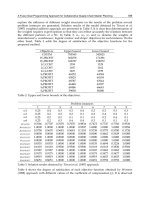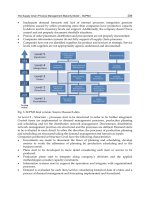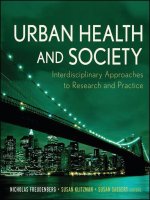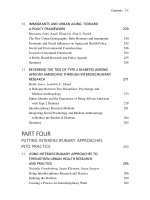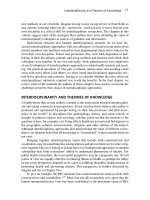Urban Health and Society: Interdisciplinary Approaches to Research and Practice - Part 5 pdf
Bạn đang xem bản rút gọn của tài liệu. Xem và tải ngay bản đầy đủ của tài liệu tại đây (145.97 KB, 10 trang )
Environmental Justice Praxis 21
to forestall displacement and develop strategies for community development and
preservation, as we discuss later.
Although neither author was trained as a public health professional, we have lear ned
to appreciate the importance of interdisciplinary knowledge and practice to solve the
pressing urban public health problems in ways that go beyond traditional epidemio logy
and traditional urban planning. We attempt to use with fl exibility the tools of applied
social science research and exchange knowledge with community activists in a way that
can lead to concrete solutions and policy changes. Our own experiences and engagement
with other practitioners confi rm that environmental justice can play a central role in the
development of new approaches that combine an understanding of holistic and multi-
level causation with complex multifaceted proposals for intervention.
In our own research and advocacy experience, we have identifi ed what we call envi-
ronmental justice praxis — a practice based on a holistic worldview that integrates
environmental justice organizing, policy analysis, and research. Environmental justice
praxis also opens up new roads to interdisciplinary practice. Our contention is that the
environmental justice movement has been a major catalyst for holistic activism, research,
and policy, and it has drawn on knowledge from a variety of fi elds. In this essay, we
focus on the integration of urban planning and public health, but we do not doubt that
important lessons can be learned from the relationships with other professional disci-
plines. We believe, therefore, that contemporary environmental justice praxis can help to
reintegrate and reimagine the fi elds of public health and urban planning in bold and
innovative ways. These two disciplines were founded over a century ago in response to
urban epidemics, but over the years, they have divided for a variety of reasons.
2 ,
5 ,
6
We draw on two case studies to illustrate what we mean by environmental justice
praxis and give examples of how it can inform the theory and practice of interdisci-
plinary public health. The fi rst is from New York City where, in response to the
concentration of waste facilities in areas with high asthma rates, environmental justice
activists played a central role in the development of a comprehensive citywide solid
waste management plan informed by principles of community health and social justice.
The second case study is in the San Francisco Bay Area where an innovative commu-
nity - based organization, Asian Pacifi c Environmental Network (APEN), works to pro-
mote environmental justice, community development, and participatory democracy in
low - income Asian immigrant and Asian American communities. Despite the signifi -
cant differences between these cases — they revolve around distinct issues (waste and
housing policies), involve different cultural and racial groups (African American,
Latino, and Asian), and are on opposite sides of the country — in both cases, activists
used environmental justice as their analytic framework to understand community
health and environmental problems and to advocate for solutions through community
organizing. In both cases, we found that disparate health and environmental effects
triggered community organizing, but we also discovered that environmental justice
advocates consistently defi ned health as more than reducing disease rates. They devel-
oped their own plans and strategies that reimagined urban development and the built
environment and advanced public health policies in broad, holistic terms.
c02.indd 21c02.indd 21 6/3/09 11:57:36 AM6/3/09 11:57:36 AM
22 Environmental Justice Praxis
To present this argument, we fi rst provide an overview of the environmental jus-
tice movement in U.S. cities and show the centrality of public health concerns in this
movement. Second, we show how the built environment can exacerbate urban public
health problems for racial minorities and how environmental justice organizing can
suggest urban planning remedies. One of the major advances of the environmental
justice movement has been its generation of strategies to reintegrate long - divided
areas of knowledge and practice, particularly urban planning and public health, and
reinject in these professions an explicitly social justice approach to health problems.
Lastly, one of the key lessons that we hope to impart to students seeking to do the hard
work of interdisciplinary, social justice oriented public health work is the importance
of understanding the relationship between social justice movements and the politics of
knowledge. By politics of knowledge, we mean how power relationships shape the
production and use of knowledge. This requires us to highlight rather than obscure
the occasionally fraught and contested relationships between communities and aca-
demic institutions.
ENVIRONMENTAL JUSTICE AND PUBLIC HEALTH
The U.S. - based environmental justice movement emerged in the 1980s as a result of a
confl uence of events and reports about the inequitable burden of toxic facilities and
pollution on low - income communities and communities of color. This brought the
terms environmental racism and environmental justice into the public sphere and policy
discourse.
7
In response to pressures from social movements — and informed by aca-
demic research — government agencies also incorporated environmental justice as a
basis for public policy at the federal, state, regional, and local levels. A landmark study
in 1987 showed how toxic sites across the country were disproportionately located in
and near communities of color.
8
In 1991, the fi rst National People of Color Conference
on Environmental Justice brought together groups from throughout the nation who
were struggling with industries, utilities, and waste facilities that contaminated their
communities and were suspected causes of major health problems such as cancer,
asthma, and respiratory disease. One outcome of this gathering was the prin ciples of
environmental justice.
9
The environmental justice movement challenges public policies
responsible for the disproportionate burden of pollution borne by people and commu-
nities of color, asserting that this is in fact a manifestation of racism.
The environmental justice movement broadly redefi ned the environment as the
places where people of color live, work, play, pray, and learn, and not just phenomena
measured by individual pollution indicators or exposure levels. The movement sought
to show how environmental health risks are not uniform across social groups or geo-
graphically; for example, racial minority children, youth, and families in the United
States disproportionately face risks associated with airborne pollution and exposure to
lead paint. At the same time, the communities where they live and go to school have
unequal access to environmental amenities such as parks and playgrounds. Thus, poor
health and inadequate access to a healthy living environment are key features of the
c02.indd 22c02.indd 22 6/3/09 11:57:37 AM6/3/09 11:57:37 AM
landscape of urban inequality, comparable to poor education, housing, income, and
social mobility. In response to these conditions, communities of color have used the
framework and language of the environmental justice movement and its focus on
disproportionate pollution exposure to combat urban health problems in cities like
San Diego, Boston, Detroit, Los Angeles, and New Orleans — in addition to our cases
in Oakland and New York City.
Although environmental concerns are not always linked in theory or practice with
public health issues, the environmental justice movement from the start established a
strong link between environmental health and the built environment that led them to
the public health and urban planning disciplines. In tackling complex urban environ-
mental health problems, community - based activists gravitate toward engagement with
the fi elds of public health and planning and many other specialized disciplines. Many
activists learn how to “ become ” planners and health practitioners when they engage
with highly specialized knowledge and practices, whether or not they are formally
educated as such at any time in their careers.
Environmental justice practice that is broadly focused on community well - being as
well as removing negative health impacts offers many opportunities for interdisciplin-
ary professional and academic work. The intrinsically complex nature and unique
characteristics of the problems activists face in large urban environments lead them to
seek broad analyses and solutions. Because they have no particular stake in maintain-
ing disciplinary boundaries, environmental justice activists are often natural partners
for interdisciplinary researchers and professionals. Interdisciplinary and holistic
approaches may help deal with complex, local problems where solutions are resistant
to conventional discipline - based approaches. This is clearly one reason that many
public health and urban planning practitioners have been naturally drawn to such
approaches. Through our case studies, we show how environmental justice practitio-
ners use technical knowledge that spans urban planning, public health, and other
disciplines, and which incorporates professional expertise to achieve broad goals of
social and environmental justice. We discuss the opportunities and barriers encoun-
tered by environmental justice advocates to illuminate these dynamics as the search for
improved urban health continues in the twenty - fi rst century.
THE BUILT ENVIRONMENT, URBAN PLANNING,
AND URBAN PUBLIC HEALTH
Public health and urban planning arose in the early part of the twentieth century as
related interdisciplinary fi elds that focused on urban public health problems and the
conditions that caused them. As the nineteenth - century urban epidemics that gave rise
to these professions subsided, the professions became more specialized and tended to
work in separate local government administrative departments. The divergence bet-
ween city planning and public health widened during the Progressive era in the early
twentieth century due to a number of complex factors.
10
At the same time, the passion
for social justice that had inspired the creation of these movements began to wane.
11
Built Environment, Urban Planning, and Public Health 23
c02.indd 23c02.indd 23 6/3/09 11:57:37 AM6/3/09 11:57:37 AM
24 Environmental Justice Praxis
The academic departments created at universities to train practitioners in these fi elds
also expanded, developed specializations, and tended to reinforce divisions among the
professions. As the presence of the professions in local governments grew, they devel-
oped complex regulatory systems and administrative institutions staffed by specialized
professionals. In the long run, these have not been well equipped to engage complex,
multifaceted health issues with multiple causes and enact policy changes to improve
urban public health. This has been particularly noticeable in large, complex urban
areas with signifi cant social and health disparities.
All applied professions are subject to a tendency toward narrow determinism
focused on quantifi able variables that are easily understood and interventions that pro-
duce immediate, local, quantifi able, and visible results that nevertheless fail to affect
larger systemic problems. Within the fi eld of urban planning in the United States,
which was initially close to engineering and architecture, criticisms have long been
raised against a prevailing tendency toward physical determinism. This refers to a ten-
dency to propose changes to the built environment as solutions to social and political
problems that require more comprehensive policy changes. Advocacy planners have
criticized the efforts of some social reformers to address urban poverty by using “ slum
clearance ” and urban renewal plans that displace poor people without necessarily
attacking the conditions that result in poverty and social exclusion. Urban planning
practice has come under fi re for a narrow focus on solving problems of transportation
mobility and access by simply building more highways or mass transit, dealing with
inadequate recreational opportunities by simply building more parks, and fi xing urban
housing problems by simply building more housing for people with limited incomes.
Jacobs
12
and Davidoff
4
have written the classic critiques of physical determinism in
planning.
Urban planners commonly utilize the comprehensive master plan and zoning as
tools to shape the physical environment. Although many master plans incorporate dis-
cussions of social equity and environmental health, for the most part they are focused
narrowly on the physical environment and often serve only as advisory documents that
are not implemented. They are most often prepared for municipal governments in
metropolitan regions that are fragmented into many small municipalities. This frag-
mentation makes it diffi cult for municipal planning to address larger urban issues,
including social, economic, and public health issues that affect entire metropolitan
regions. Social and economic inequalities between municipalities are often signifi cant.
While regional planning could reduce fragmentation and inequalities, three - fourths of
the nation ’ s urban population live in large metropolitan regions with no comprehensive
regional planning. As a result, market forces play a substantial role in land - use devel-
opment, and the options of planning at the municipal level are limited. Zoning is urban
planning ’ s main regulatory tool that governs where and what kind of new development
can occur. But while zoning originally separated land uses such as industry and hous-
ing to improve public health, it has come to be used as a mechanism for reinforcing
social and racial separation.
13
c02.indd 24c02.indd 24 6/3/09 11:57:37 AM6/3/09 11:57:37 AM
Since the 1980s, concurrent with the emergence of the environmental movements,
urban planning began to branch into areas once exclusively occupied by public health
and other professional disciplines. At a global level, the 1987 United Nations Confer-
ence on the Environment put forth the concept of sustainability — generally defi ned as
addressing current needs without compromising the needs of future generations —
which challenged all professions to engage in holistic analysis that moves beyond
individual and easily defi ned measures. Planning for sustainability is a rapidly growing
practice that includes environmental and public health concerns.
14
,
15
In response to
criticisms that urban planners contributed to the predominant pattern of suburban
sprawl and the consequent problems of air pollution and auto dependence, energy
waste, and the disappearance of farmland at urban peripheries, urban planners began to
advocate for land - use policies that concentrated new development in already - developed
areas. This “ smart growth ”
16
became a trademark of the American Planning Association.
A group of architects and planners known as The New Urbanists emerged in recent
decades and called for healthy, walkable communities and transit - oriented develop-
ment that would reduce dependence on the private automobile and create healthier,
more active cities.
17
To some extent, this has fed the growing intensity of real estate
development in metropolitan regions, but it also spurred a renewal of interest in the
public health consequences of urban growth, particularly the rise in the epidemics of
asthma, obesity, and diabetes.
Often citing public health concerns, some urban planners have become advocates
for better pedestrian, bicycle, and mass transit infrastructure.
18
,
19
Others have begun to
address problems of access to healthy food.
20
–
22
And in a link with the advocacy
planning and the civil rights movements of the 1960s, many have focused on community -
based planning as a tool for addressing the disparate impact of urban epidemics in a
comprehensive, holistic fashion.
3
Still, the tendency toward physical determinism
remains powerful. For example, researchers are now calling into question facile claims
that building some new parks and bikeways will automatically induce greater physical
activity and thus address epidemics such as obesity. In the area of housing, city plan-
ners have rejected the older myths that large - scale government - subsidized housing
complexes would necessarily improve the lives of poor people, but many planners
have also embraced the new myth that smaller scale, mixed - income housing would
necessarily be better.
23
As a result, urban planners continue to give a lower priority to
the preservation of housing in low - income communities and policies like rent control
that help stabilize the lives of families and communities.
Because public health practitioners are increasingly looking at ways in which pol-
icies affecting the built environment can foster public health, it appears that there is
now a greater appreciation in both professions for the historical roots that bound public
health and planning together as interdisciplinary and related fi elds, both deeply
concerned with social justice. This accompanies a growing understanding that they
need to be brought together again to resolve today ’ s new and complex urban issues.
Environmental justice praxis can help foster this trend. It is not simply a matter of
Built Environment, Urban Planning, and Public Health 25
c02.indd 25c02.indd 25 6/3/09 11:57:37 AM6/3/09 11:57:37 AM
26 Environmental Justice Praxis
adding public health and urban planning tools to create a larger toolkit of practice but
integrating the knowledge and experience from both fi elds. Although we have found
that environmental justice activists often adopt the language and methods of urban
planning, the scope of their practice transcends traditional urban planning, master
plans, and zoning, as well as the new tools such as environmental impact statements
that address narrow environmental concerns without necessarily looking at larger,
cumulative impacts. Thus, while urban public health practitioners may learn from col-
laborations with urban planning practitioners, both face the challenge of moving
beyond institutional borders and regulatory boundaries to solve broader problems and
incorporate social justice as a fundamental principle.
For example, in arguing for innovative approaches to housing and health, Roderick
Lawrence rejects the biomedical model and advocates a holistic approach that incor-
porates biological, cultural, economic, political, psychological, and social elements.
24
He proposes an ecological approach to health that looks at four components: (a) the
individual, including genetic makeup; (b) agents and vectors (disease); (c) the physical
and social environment; and (d) available resources. Ultimately, Lawrence defi nes
health as not only freedom from disease but as the relationship of people to their social
environment. Health allows people to achieve their potential in life. He defi nes housing
as both a product and a process. Thus, planners and health professionals should not
only focus on removing negative health impacts but also work to promote well - being
through a careful focus on communities. This emphasis on urban community health,
defi ned as more than removing pollution or the absence of disease, is also clear in
housing - based environmental justice campaigns that link public health and urban plan-
ning, as shown in our second case study.
ENVIRONMENTAL AND SOCIAL JUSTICE, INTERDISCIPLINARITY,
AND THE POLITICS OF KNOWLEDGE
We have defi ned environmental justice praxis as a holistic integration of organizing,
policy analysis, and research. Environmental justice praxis also opens new roads to
interdisciplinary practice. In this section, we discuss some key examples of research that
we believe exemplify this integration of organizing, policy analysis, and research. These
examples are particularly signifi cant because they squarely focus on the social justice
question: Why do so many racial minorities in urban and disenfranchised communities
face such high rates of pollution exposure and the ensuing health risks?
Environmental justice activists are heavily invested in understanding why com-
munities of color are disproportionately impacted by diseases that have an urban and
environmental health component, such as asthma and lead poisoning. Health - disparities
research and social epidemiology focus on “ extrinsic ” factors such as class, race, and
power dynamics.
25
Environmental justice activists have also been a key factor in inno-
vative public and environmental health research on complex urban problems such as
disproportionately high minority childhood asthma rates.
26
Two recent studies, one in
c02.indd 26c02.indd 26 6/3/09 11:57:37 AM6/3/09 11:57:37 AM
New York and another in California, suggest new paths to knowledge emerging from
environmental justice praxis.
The fi rst study is Jason Corburn ’ s Street Science: Community Knowledge and
Environmental Health Justice.
27
In this book, Corburn discusses environmental justice
activism and asthma research as one of his examples of “ street science, ” which he
defi nes as a framework that joins local insights with professional and scientifi c
methods. The goal of street science is to improve scientifi c inquiry, environmental
health policy, and decision making. At the heart of Street Science are four case studies
from Greenpoint/Williamsburg in New York City, where diverse racial and ethnic,
low - income populations practice what he calls “ science on the streets of Brooklyn. ”
The other case studies by Sze are on asthma, childhood lead poisoning, and small
sources of air pollution.
2
Sze ’ s study discusses asthma activism in West Harlem,
another New York City neighborhood. Some of the larger issues addressed through
these particular studies include the limits of traditional risk assessment and the politics
of mapping health and environment risk.
Through these studies, Corburn provides a theoretical model for understanding
key characteristics of what he calls “ local knowledge, ” its paradoxes, and its contribu-
tions to environmental health policy. Street science, at its best, identifi es health hazards
and highlights research questions that professionals may otherwise ignore, provides
hard - to - gather exposure data, involves diffi cult to reach populations, and expands possi-
bilities for interventions, resulting in what he calls “ improved science and democracy. ”
Using a framework common among urban planners, Corburn explicitly calls for envi-
ronmental and public health researchers, policymakers, and urban planners to become
what Schön has called “ refl ective practitioners. ”
28
At the same time, he is careful to
reject the idea of street science as a panacea. He states that it does not devalue but rather
revalues science. He is not calling for a populism where the “ community ” replaces
“ experts ” but for a better understanding of how knowledge that is “ co - produced ” by
local and professional constituencies can lead to better health, science, and policy. This
is consistent with other theoretical frameworks that emphasize the social production of
knowledge. (See also Chapter One in this volume.)
Second, a series of major studies conducted in Los Angeles highlights how environ-
mental and health inequalities are produced and reproduced. To highlight just one study,
a 2004 analysis of ambient air toxics exposure and health risks among schoolchildren in
Los Angeles found that African American and Latino youth bear the largest share of the
burden of air pollution risks and that the respiratory hazards associated with air toxics
appear to negatively affect indices of academic performance.
29
The research collaborative
that conducted this study is notable for several reasons. First, the team is interdisciplinary
in its composition: Pastor is an economist, Morello - Frosch is from public health, and
Sadd is a geographer. Second, their interdisciplinary research was explicitly linked to
environmental justice organizing. Third, the work addressed public policy.
The same collaborative team performed similar research in the San Francisco Bay
Area. They completed a report, “ Still Toxic After All These Years: Air Quality and
Environmental & Social Justice, Interdisciplinarity, & Politics of Knowledge 27
c02.indd 27c02.indd 27 6/3/09 11:57:38 AM6/3/09 11:57:38 AM
28 Environmental Justice Praxis
Environmental Justice in the San Francisco Bay Area ”
30
for the Bay Area Environmental
Health Collaborative, which includes some of the area ’ s leading environmental justice
and community health organizations. Their research is one of the few examples of team -
based research in environmental justice, and each brings its own disciplinary methods to
the larger collaboration. Team - based research is common in scientifi c disciplines and in
public health but is far less common in urban planning and has rarely been used within
an environmental justice framework.
In utilizing different disciplinary methods and frameworks, this research collabor-
ative was able to ask better questions and provide better answers than existing research
on air pollution in California. Their collaboration clearly “ adds value ” and opens up
new ways of looking at phenomena beyond those favored in their disciplinary training.
For example, Morello - Frosch, a trained public health specialist, in a critique that
focuses on the political economy of place, thinks and writes in a disciplinary tradition
distinct from the one she was trained in and partly draws from geography and ethnic
studies.
31
By integrating relevant social and legal theories with a spatialized economic
critique, she formulates a more supple theory of environmental discrimination that
focuses on historical patterns of industrial development and racialized labor markets,
suburbanization and segregation, and economic restructuring. Morello - Frosch et al.
29
discuss their collaboration, a multiyear project working with Communities for a Better
Environment, a community - based organization in Los Angeles and the Bay Area.
This research collaborative has helped draw attention to the use of the precaution-
ary principle in environmental justice praxis. This principle calls for preventing harm
to the environment and human health by shifting the burden of proof from regulatory
bodies and residents to polluters and producers, who must demonstrate the safety of
a new product, process, or urban development proposal. Public health and cancer activ-
ists have advanced this notion with respect to asthma.
Environmental justice activists
are a major constituency among urban health advocates supporting the precautionary
principle, particularly around asthma.
2
,33
This interdisciplinary research has also had a signifi cant impact on policy, particu-
larly at agencies like the California Air Resources Board where the researchers
received a large grant for a study, “ Integrating Indicators of Cumulative Impact and
Socioeconomic Vulnerability into Regulatory Decision - making. ”
34
In addition to peer
validation and respect from state agencies looking for guidance and research to direct
policy, the research has enabled Morello - Frosch and her colleagues to continue to col-
laborate with community groups. For example, the group was contracted to write a
report for the Bay Area Environmental Health Collaborative,
30
a coalition of groups
concerned with air quality and its health impacts.
Corburn ’ s Street Science and the interdisciplinary research of Pastor, Morello -
Frosch, and Sadd show how engagement with social movements can drive innovative
interdisciplinary research that asks better questions and informs urban public health
policy. We now turn to our case studies to illustrate how the opportunities and chal-
lenges for environmental justice praxis can further advance urban public health.
c02.indd 28c02.indd 28 6/3/09 11:57:38 AM6/3/09 11:57:38 AM
Asthma & Environmental Justice Campaign for Solid Waste Plan 29
ASTHMA AND THE ENVIRONMENTAL JUSTICE CAMPAIGN
FOR A SOLID WASTE PLAN IN NEW YORK CITY
The environmental justice movement in New York City emerged in response to public
health crises that had particularly signifi cant impacts in low - income communities of
color. The most important of these crises was asthma. The highest child hospitalization
rates for asthma tend to be concentrated in low - income neighborhoods, among which
the South Bronx, Harlem, and Central Brooklyn stand out, as shown in Figure 2.1 .
FIGURE 2.1 Asthma Cases by Zip Code, 2000
Credit: Carlos Jusino, West Harlem Environmental Action Coalition.
c02.indd 29c02.indd 29 6/3/09 11:57:38 AM6/3/09 11:57:38 AM
30 Environmental Justice Praxis
Neighborhood activists in these areas made the connection between high asthma rates
(and other respiratory illnesses) and the concentration of noxious facilities, including waste
transfer stations, bus depots, and dense highway networks. For those who live and work
near such facilities, the operations at these facilities exacerbate asthma because of increased
truck traffi c, odors, noise, and vermin.
2
Given that most of the polluting activities involve
functions that provide citywide and regional services, environmental justice activists found
themselves confronting the need to understand not only their own neighborhoods but the
larger city and region. In addition, activists focused not only on asthma but its relationship
to broader issues of community well - being, to come up with effective solutions.
In July 2006, the New York City Council approved an updated Solid Waste Mana-
gement Plan (SWMP) covering the city ’ s fi ve boroughs, which have a total population
of about 8 million people. This complex, highly technical citywide plan was in large
part an outgrowth of a plan put together years earlier by a coalition of neighborhood
groups led by environmental justice activists in the Organization of Waterfront
Neighborhoods (OWN). OWN formed in 1996 and, with the help of the Consumers
Union, put forth a plan that attempted to provide a comprehensive, citywide solution
to the waste problem. OWN ’ s members, mostly neighborhood - based groups concerned
about the health consequences of the concentration of privately owned waste transfer
stations in their neighborhoods, developed a broad citywide strategy. The neighbor-
hood activists, not the trained land - use or engineering professionals, were the catalyst
for a more holistic, comprehensive city plan that cut across neighborhoods and disci-
plines. The urban planning and health departments were, for the most, absent from the
offi cial planning process, which was concentrated mostly in the Department of
Sanitation, which contracted out the plan to engineering consultants.
Background and Genesis of the OWN Plan
In 1987, the city raised the fees it charged to private haulers to dump in the Fresh Kills
landfi ll, the last of the city ’ s landfi lls, the largest in the world, and an environmental
hazard for the area in Staten Island where it is located. In 1998, Mayor Rudolph
Giuliani announced the closing of the Fresh Kills landfi ll, in part to pay a political debt
to the Borough of Staten Island, a largely European American borough that had given
Giuliani the margin of votes he needed to win the election. In 2001, the last city sanita-
tion truck made its delivery to Fresh Kills. Most of the city ’ s waste is now exported
under contract with the city.
Starting in 1987, however, the private waste haulers established some eighty - fi ve
waste transfer stations in the city where waste could be sorted and put on large tractor -
trailers for shipment out of state. The waste companies went where land was cheapest
and zoning permitted them. As a result, about 70 percent of all putrescible waste (all
commercial waste, including food, except for construction waste and fi ll) went through
transfer stations in north Brooklyn and the south Bronx, in and near low - income com-
munities (the racially and geographically disproportionate problem of waste transfer
station siting is not unique to New York City; see Pellow
35
). They brought with them
heavy truck traffi c, diesel fumes, noise, odors, vermin, and increased risks for asthma
c02.indd 30c02.indd 30 6/3/09 11:57:39 AM6/3/09 11:57:39 AM


